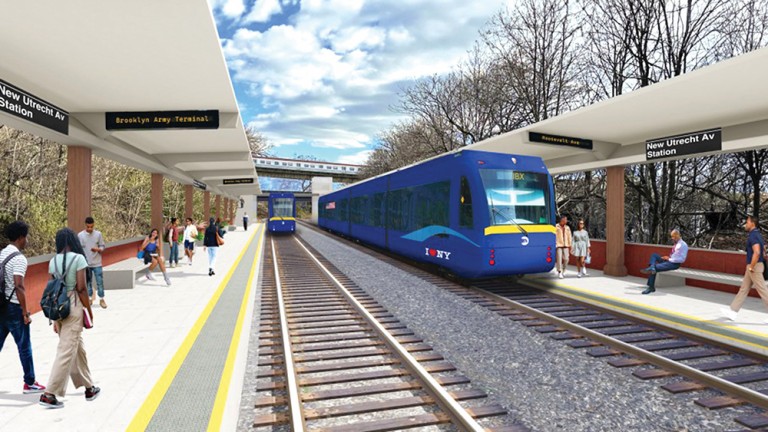By Forum Staff
Governor Hochul on Friday announced that the Interborough Express project has advanced to the engineering and design phase.
The IBX light rail system would connect historically underserved communities in Queens and Brooklyn to the subway, bus and Long Island Rail Road, while significantly reducing travel times between Brooklyn and Queens, with an end-to-end run time of 32 minutes along the 14-mile line.
Last Wednesday, the MTA Board authorized the selection of a joint venture between Jacobs and HDR as the team that will oversee the design and engineering phase of the IBX. In April, Hochul approved $2.75 billion in funding for the project.
According to the authority, the IBX will be a new transit option for close to 900,000 residents living in neighborhoods along the route, along with 260,000 people who work near the corridor in Brooklyn and Queens. It will create 19 stations and connect with 17 different subway lines—A, C, E, N, Q, R, 2, 3, 5, 7, B, D, F, M, J and L trains—50 bus routes and two LIRR stations. The project will be built along an existing, 14-mile freight line owned by the MTA LIRR and CSX Corp. that extends from Sunset Park, Brooklyn, to Jackson Heights. New York and Atlantic Railway currently operates freight rail on the corridor under a concession agreement on the LIRR branch.
The IBX will be the first new end-to-end rapid transit built entirely within New York City since the IND Crosstown Line, now called the G, fully opened in 1937. IBX stations built in Brooklyn will be the first transit stations built in the city’s most populous borough since the A line extended from Broadway Junction to Euclid Ave in 1948. IBX stations in Queens will be the first new transit stations built since the Archer Avenue extension of the E, J and Z lines to Jamaica in 1988.
Project design will officially kick off this summer, focusing on light rail system design including: communications and signal design, vehicle design, track design, plus civil engineering efforts such as station design, bridge reconstruction and retaining wall design and design of the operations facility and storage yard. The design process is the last major step in the project before formal construction begins.
The project has undergone further refinement to ensure that it will provide the best service for passengers for the best value. In Middle Village, the MTA is progressing with the design of a tunnel solution beneath Metropolitan Avenue, rather than on-street operations, making the proposed line less prone to travel delays due to mixed traffic operations. This refinement has reduced projected running times of the new line from 39 minutes to 32 minutes and has increased ridership projections to 160,000 per day, up 50,000 from the MTA’s prior estimate. IBX’s projected annual ridership is higher than the current ridership of any other light rail system in the country at 48 million riders — the next largest is Los Angeles at 46 million riders per year.
Light rail was determined to offer the best service to riders at the best value to the MTA, with about 70 percent of projected IBX riders transferring within the MTA system. Station locations were selected based on public feedback, ridership projections, ability for riders to transfer to other parts of the MTA network, constructability, and spacing.

